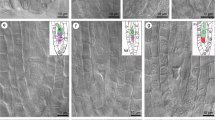Summary
In the microsporangium of Pinus the outer layer of the peritapetal membrane and the pro-orbicular cores are not only formed in a similar manner, but are composed of apparently identical materials. Precursors for this lipoidal material are produced by the tapetal protoplasts, as are the precursors of sporopollenin. Production the precursors is sequential and appears to involve different cytoplasmic structures.
The sporopollenin synthesised by the tapetum condenses upon the pro-orbicular cores, the peritapetal membrane, the exine initials and, on fragmentation of the tapetum, parts of the disintegrating cytoplasm. The evident unpolarised nature of the tapetal protoplasts, and the sequential nature of the synthesis of the lipoid and the sporopollenin by them, may point to orbicule formation in gymnosperms being a necessary by-product of the development of the peritapetal membrane.
Similar content being viewed by others
References
Avetissian, N. M.: Method simplifiée d'acetolyse dans la préparation des pollens. J. Bot. U.R.S.S.T. 35, 385–386. (1950).
Dickinson, H. G.: The fine structure of a peritapetal membrane investing the microsporangium of Pinus banksiana. New Phytol. 69, 1065–1068 (1970a).
Dickinson, H. G.: The role played by sporopollenin in the development of pollen in Pinus banksiana. In: Sporopollenin, ed. J. Brooks, P. R. Grant, M. D. Muir, P. van Gijzel and G. Shaw, p. 31–67. London: Academic Press 1970b.
Echlin, P., Godwin, H.: The ultrastructure and ontogeny of pollen in Helleborus foetidus L. I. The development of the tapetum and Ubisch bodies. J. Cel Sci. 3, 161–174 (1968).
Heslop Harrison, J.: An acetolysis resistant membrane investing tapetum and sporogenous tissue in the anthers of certain Compositae. Canad. J. Bot. 47, 541–542 (1969).
Heslop Harrison, J., Dickinson, H. G.: Time relationships of sporopollenin synthesis associated with tapetum and microspores in Lilium. Planta (Berl.) 84, 199–214 (1969).
Martino, C. de, Natali, P., Bruni, C., Accinni, L.: Influence of plastic embedding on staining and morphology of lipid bodies. Histochemie 16, 350–360 (1968).
Pettitt, J. M.: A new interpretation of the structure of the megaspore membrane in some gymnospermous ovules. J. Linn. Soc. (Bot.) 59, 253–262 (1966).
Reynolds, E. S.: The use of lead citrate at a high pH as an electron opaque stain in electron microscopy. J. Cell Biol. 17 p. 208–212 (1963).
Author information
Authors and Affiliations
Rights and permissions
About this article
Cite this article
Dickinson, H.G., Bell, P.R. The rôle of the tapetum in the formation of sporopollenin-containing structures during microsporogenesis in Pinus banksiana . Planta 107, 205–215 (1972). https://doi.org/10.1007/BF00397936
Received:
Issue Date:
DOI: https://doi.org/10.1007/BF00397936




